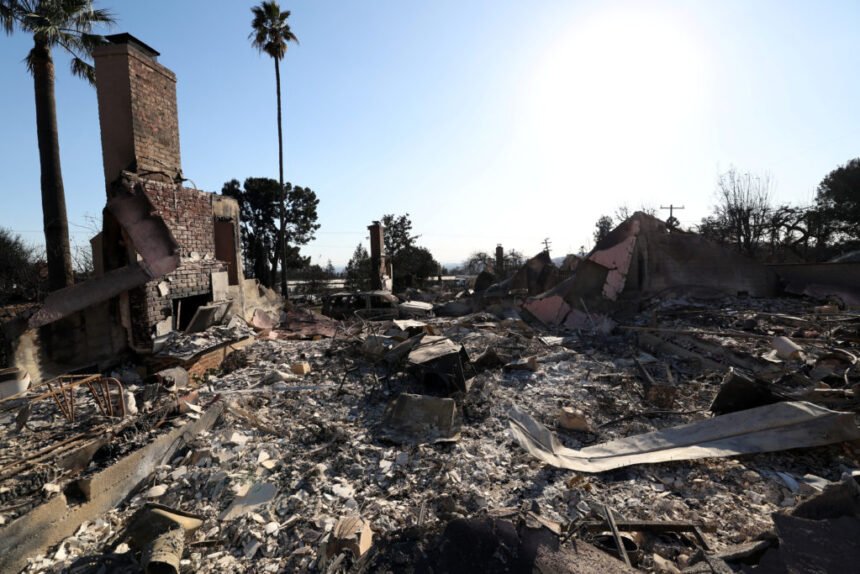The Eaton Fire, one of the most devastating wildfires in California’s history, has led to multiple lawsuits against Southern California Edison (SCE), alleging that the utility company’s equipment was responsible for igniting the blaze. The fire consumed over 14,000 acres, destroyed 10,000 structures, and tragically claimed at least 177 lives.
This legal battle raises significant questions about corporate responsibility, wildfire mitigation, and the broader implications for utility companies operating in fire-prone regions. This article provides a detailed analysis of the lawsuit, the evidence presented, and what this case means for future wildfire liability claims.
Background: The Eaton Fire and the Allegations Against SCE
On January 8, residents of Altadena, California, were awakened by emergency evacuations as the Eaton Fire, fanned by hurricane-force winds, rapidly spread across the region. Among those affected was Evangeline Aesus, who, along with her daughter, escaped with nothing but a suitcase. By sunrise, their home of 25 years was reduced to rubble.
Several lawsuits have been filed against Southern California Edison, alleging that the company failed to take adequate precautions despite clear weather warnings. One law firm released a video that appears to show sparks falling from utility equipment onto dry vegetation just before the fire began.
Key Legal Claims in the Lawsuit
The plaintiffs in the lawsuit are primarily arguing the following legal points:
- Negligence – The suit claims that Southern California Edison failed to shut off power lines despite knowing about dangerous wind conditions that could trigger a fire.
- Inverse Condemnation – This legal doctrine holds that if a public utility’s equipment causes damage, it must compensate affected individuals, regardless of negligence.
- Failure to Maintain Equipment – The plaintiffs argue that inadequate maintenance of transmission lines contributed to the fire’s ignition.
Southern California Edison’s Response
Edison CEO Pedro Pizarro has stated that the company has not yet fully inspected its lines but claims that preliminary data shows no electrical anomalies in the fire’s area of origin. The company insists that it follows state-regulated wildfire mitigation plans to minimize risks.
When asked whether Edison had done everything possible to prevent the fire, Pizarro responded:
“I am confident that Edison has the processes, procedures, and controls in place to maintain system safety. However, we cannot yet determine whether something was missed or if an accident occurred.”
Despite these claims, many affected residents remain skeptical, pointing to past cases where utility companies were found liable for similar disasters.
Challenges in Proving Liability
For the plaintiffs, proving liability will be a complex process that hinges on:
- Establishing that SCE had a duty to act (e.g., shutting down power lines before high winds arrived).
- Demonstrating that SCE failed in this duty.
- Providing sufficient evidence that this failure directly caused the fire.
If the case proceeds to trial, a jury will ultimately decide whether Edison is financially responsible for the damages.
Impact on Wildfire Liability and Public Utilities
This lawsuit is part of a growing trend where utility companies face legal consequences for wildfires linked to their infrastructure. In recent years:
- Pacific Gas & Electric (PG&E) declared bankruptcy after being held liable for multiple fires in California.
- Hawaiian Electric is facing lawsuits for its role in the Maui wildfires of 2023.
If the plaintiffs succeed, it could force SCE and other utilities to implement stricter safety measures, such as more aggressive power shutdowns during high-risk weather events.
—————————-
The Eaton Fire lawsuit against Southern California Edison highlights the growing accountability of utility companies in wildfire-prone areas. While the case is still in its early stages, its outcome could have far-reaching consequences for both fire victims and energy providers.
As the legal battle unfolds, affected residents continue to rebuild their lives, hoping for justice and greater corporate responsibility in wildfire prevention.
A law firm released a video allegedly showing sparks from Edison’s equipment igniting the hillside. Additionally, weather warnings had predicted dangerous wind conditions before the fire.
Plaintiffs must prove that Edison had a duty to act, failed to do so, and that this failure directly caused the fire. Edison denies any anomalies in its electrical system, which could make proving liability difficult.
If Edison is found liable, it could set a precedent that forces utilities to implement stricter wildfire prevention measures, including preemptive power shutoffs in high-risk conditions.






